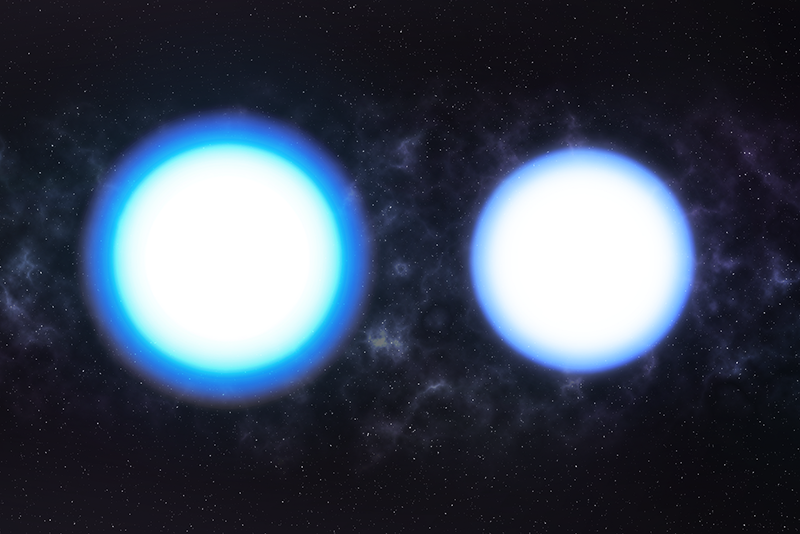By William Roy
A student-led team has observed that the mass-radius relation of white dwarf stars, a type of star which is so dense that they are supported by quantum mechanical effects, depends on the temperature of the star. Scientists have long searched for this subtle effect, detected here for the first time using a method from General Relativity – along with the largest catalog of white dwarf data of its kind.

Click on the image for a larger version.
Image Credit: Roberto Molar Candnosa, Johns Hopkins University
When a star has burned up all of its fuel and no longer generates much energy, it sheds its outer layers. What remains is a super dense core known as a white dwarf star. Young white dwarfs can be as hot as 100,000 degrees Celsius (180,000° Fahrenheit) or more. Since they have no source of energy, the dying core of the star will gradually cool over billions of years.
Although only the size of the Earth, white dwarfs have an average mass similar to our sun, making them so dense that just a teaspoon of material from the typical white dwarf would weigh several tons on Earth. This incredible density has fascinating effects on the structure of these stars, summed up in a theory that dates back to the 1930s by Nobel Prize in Physics recipient Subrahmanyan Chandrasekhar. The theory, called the “mass-radius relation,” suggests that white dwarfs with more mass are actually smaller in size (radius) due to quantum mechanical effects.
In a new paper published today in The Astrophysical Journal, a team led by PhD candidate Nicole Crumpler of Johns Hopkins University has detected a long-theorized but very subtle effect in the white dwarf “mass-radius relation.”
This effect? The radius of white dwarf stars depends not only on the star’s mass, but also on its temperature. This temperature dependence spawns from the nature of the gases in the outermost layers of white dwarfs, which behave like an “ideal gas.” An ideal gas is one in which the theoretically perfect balance of volume, pressure, temperature, and number of atoms keeps it stable. Think of it like a balanced scale: on one end is pressure and volume (size), and on the other is temperature and number of atoms (mass). If the mass and pressure remain the same and temperature increases, then for the gas to stay balanced, its volume must also increase. The volume – and therefore the radius – of a hotter white dwarf is larger, because the white dwarf’s outer envelope of gas puffs up just a little bit.
This “puffiness” due to higher temperature is a very small effect, meaning the team had to measure the properties of white dwarf stars very precisely – more precisely than normally would be possible. The team had to use a clever trick by focusing on “gravitational redshift,” a subtle effect observable only in very dense stars such as white dwarfs.
Gravitational redshift was first predicted by Albert Einstein in 1907 as part of his groundbreaking theory of general relativity. Light has a certain color that depends on its energy; when light travels away from a high-mass object such as a white dwarf, the gravitational pull of that object “steals” some of the energy from the light. As a result, the light’s wavelength becomes longer, shifting toward the red end of the spectrum – the light we observe is “redshifted.” The stronger the gravitational force – which depends on the mass and the radius of the object – the more the light gets gravitationally redshifted.
The team’s previous 2020 study – led by undergraduate student Vedant Chandra, now a PhD candidate at Harvard University – used gravitational redshift measurements to find that White Dwarfs with greater masses have smaller radii on average, directly confirming Chandrasekhar’s hundred-year-old prediction. The team wanted to follow up their discovery by looking for the temperature-radius relation, but there were not enough observations to tell. They left questions about temperature for future datasets.
That future is now, and with many new observations of white dwarf stars from SDSS and the Gaia space telescope, the team has assembled the largest white dwarf catalog of its kind. Their catalog contains more than 26,000 white dwarfs, all analyzed with newly refined techniques to measure gravitational redshift.
“It’s fascinating to finally see the temperature-dependence of the mass-radius relation so clearly with these new datasets, and also to think about what’s next,” said Chandra. “Spectroscopic samples of white dwarfs could grow tenfold over the next decade.”
To prove that temperature affects the mass-radius relation of white dwarfs, the team split their large catalog into two groups: hot stars and cold stars. They measured the gravitational redshifts of each group and found that warmer white dwarfs, on average, have greater gravitational redshifts than cooler ones at a given radius.
Contacts
Nicole Crumpler
Johns Hopkins University
ncrumpl2@jhu.edu
Vedant Chandra
Harvard University
vedant.chandra@cfa.harvard.edu
William Roy
Contributing Press Writer, Sloan Digital Sky Survey
liamoflancaster@gmail.com
This observation means that warmer white dwarfs of a particular size are typically more massive than their cooler counterparts. Due to the vast size of the new and improved catalog, the team has determined these results to be statistically significant. This means these astrophysicists can say, with confidence, that their findings have confirmed the long-theorized temperature dependence of the structure of white dwarf stars and refined our understanding of the universe.
“Detecting this subtle temperature dependence is just one example of the amazing things astronomers can accomplish with large data sets like SDSS,” said Crumpler. “Already we are using this catalog of white dwarfs to investigate new signals of dark matter hidden in the structure of these stars.”
The findings from this study are a leap forward in our understanding of white dwarfs, but this is only the beginning. With many more observations planned in the future, scientists are poised to unlock even more secrets of these fascinating stars, bringing us closer to solving some of the universe’s most profound mysteries.
Other versions
Johns Hopkins University: Survey of 26,000 dead stars confirms key details of extreme stellar behavior
About the SDSS
Funding for the Sloan Digital Sky Survey V has been provided by the Alfred P. Sloan Foundation, the Heising-Simons Foundation, the National Science Foundation, and the Participating Institutions. SDSS acknowledges support and resources from the Center for High-Performance Computing at the University of Utah. SDSS telescopes are located at Apache Point Observatory, funded by the Astrophysical Research Consortium and operated by New Mexico State University, and at Las Campanas Observatory, operated by the Carnegie Institution for Science. The SDSS web site is www.sdss.org.
SDSS is managed by the Astrophysical Research Consortium for the Participating Institutions of the SDSS Collaboration, including Caltech, the Carnegie Institution for Science, Chilean National Time Allocation Committee (CNTAC) ratified researchers, The Flatiron Institute, the Gotham Participation Group, Harvard University, Heidelberg University, The Johns Hopkins University, L’Ecole polytechnique fédérale de Lausanne (EPFL), Leibniz-Institut für Astrophysik Potsdam (AIP), Max-Planck-Institut für Astronomie (MPIA Heidelberg), Max-Planck-Institut für Extraterrestrische Physik (MPE), Nanjing University, National Astronomical Observatories of China (NAOC), New Mexico State University, The Ohio State University, Pennsylvania State University, Smithsonian Astrophysical Observatory, Space Telescope Science Institute (STScI), the Stellar Astrophysics Participation Group, Universidad Nacional Autónoma de México, University of Arizona, University of Colorado Boulder, University of Illinois at Urbana-Champaign, University of Toronto, University of Utah, University of Virginia, Yale University, and Yunnan University.
